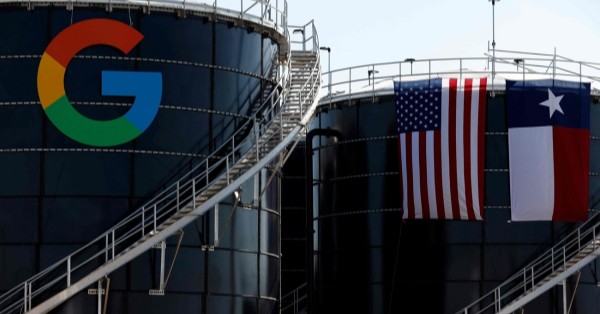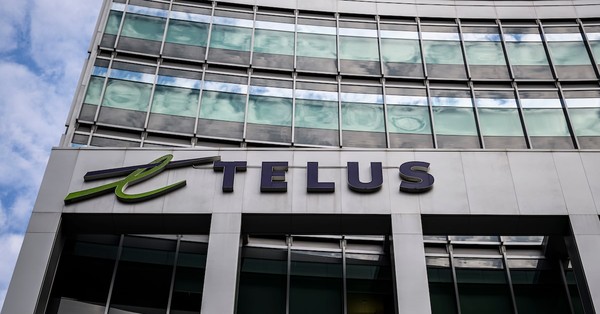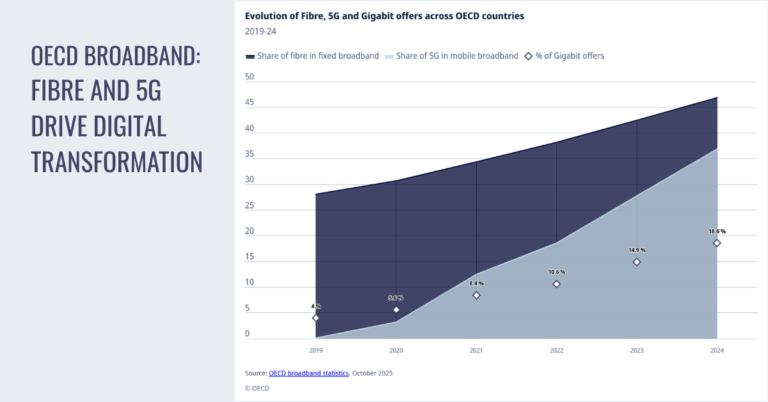- Tech News & Insight
- November 18, 2025
- Hema Kadia
Home » Sustainability
Sustainability
- Tech News & Insight
- November 18, 2025
- Hema Kadia
Alphabet’s Google will spend $40 billion to build three AI-focused data centers in Texas, signaling that power access and grid proximity now define hyperscale strategy more than any single technology feature. The build spans one campus in Armstrong County in the Texas Panhandle and two in Haskell County near Abilene, with investments running through 2027. Google expects the program to create thousands of construction and supplier jobs and hundreds of long-term operations roles, consistent with typical hyperscale staffing patterns. Texas offers relatively low-cost power, faster interconnection timelines, abundant land, and pro-investment policies, making it second only to Virginia in U.S. data center count.
- Tech News & Insight
- November 16, 2025
- Hema Kadia
Amazon has moved its low Earth orbit broadband effort out of code-name mode and into a market-facing brand with strategic implications for telecom and enterprise buyers. Project Kuiper is now Amazon Leo, a direct reference to the low Earth orbit constellation underpinning the service. The rebrand signals a transition from R&D to commercial execution. Amazon reports more than 150 satellites in orbit today—roughly 153 by recent counts—following a string of successful launches and a completed prototype mission. The company says it will light up service as it adds coverage and capacity.
- 5G, API, Automation, IoT, Orchestration, SASE, SD-WAN, Security, Sustainability
- 3GPP, America, Aviation, AWS, Broadband, Cisco, Eutelsat OneWeb, Fiber, Fortinet, LEO, Mobility, MVNO, Palo Alto Networks, Partnerships, Policy, SpaceX, Starlink, Telesat
- Retail, Telecom
- Tech News & Insight
- November 12, 2025
- Hema Kadia
Alphabet will invest €5.5 billion in Germany through 2029 to expand AI-capable cloud infrastructure and office capacity, anchoring new buildouts in the Frankfurt Rhine-Main region. Google will construct a new data center in Dietzenbach, near Frankfurt, and continue scaling its Hanau campus opened in 2023. With Frankfurt’s role as Europe’s interconnection hub—home to DE-CIX—placement in Rhine-Main positions Google to serve latency-sensitive AI, analytics, and financial services workloads. Google Cloud will bring expanded capacity for services such as Vertex AI and Gemini models into its German regions, enabling enterprises to run training, fine-tuning, and inference closer to users and data.
- Tech News & Insight
- November 11, 2025
- Hema Kadia
Nokia will remain TNN’s sole 5G RAN and managed services supplier for four more years, underpinning Denmark’s next phase of high-performance, energy-efficient, and increasingly autonomous mobile networks. The renewed agreement modernizes TNN’s nationwide 5G footprint with Nokia’s AirScale Radio Access Network portfolio and AI-driven MantaRay solutions to improve speed, capacity, and customer experience for more than three million users. Deployment highlights include Habrok Massive MIMO radios for mid-band capacity, Pandion multi-band remote radio heads for broad coverage, and AI-ready AirScale basebands (Ponente, Lodos, Levante) powered by ReefShark system-on-chip silicon to scale throughput while reducing power consumption.
- 5G, AI, Automation, IoT, Open RAN, RAN, SD-WAN, Sustainability
- Fiber, Investment, Mobility, Nokia, Spectrum, Telenor
- Tech News & Insight
- November 11, 2025
- Hema Kadia
A cascade of offers from OpenAI, Google, and Perplexity—amplified by Airtel and Reliance Jio—signals a deliberate push to convert India’s scale into durable AI usage, data, and future revenue. With more than 900 million internet users, rock-bottom mobile data prices, and a young, mobile-first population, India offers the world’s deepest top-of-funnel for AI adoption. Giving away premium access—such as a year of ChatGPT’s low-cost “Go” tier, Jio’s bundling of Gemini, or Airtel’s tie-up with Perplexity Pro—maximizes trial, habituation, and data collection across diverse languages and contexts. Even a low single-digit conversion rate translates into millions of subscribers, while non-converters still contribute valuable signals that improve models.
- Tech News & Insight
- November 11, 2025
- Hema Kadia
Telus is in active talks to bring partners into its data-centre and AI business, signaling a capital-light approach to scale sovereign AI compute in Canada. Partner capital can accelerate GPU procurement, facility buildouts, and interconnect investments while aligning with customers that require sovereign environments distinct from hyperscale public clouds. Management addressed investor concerns about potential AI compute oversupply by emphasizing a modular build strategy, adding capacity in phases as demand materializes. The timing aligns with tightening data-residency requirements, heightened AI adoption, and demand for local alternatives to U.S.-centric infrastructure. This reduces stranded capital risk in a market with volatile GPU supply, rapid chip roadmaps, and evolving workload profiles.
- Tech News & Insight
- November 6, 2025
- Hema Kadia
SoftBank and OpenAI have formed SB OAI Japan, a jointly owned entity that will commercialize “Crystal intelligence,” a bundled enterprise AI offering focused on management and operations in Japan. The venture will combine OpenAI’s enterprise-grade models and tooling with localization, integration, and support led by SoftBank in-market. Crystal intelligence is positioned as a turnkey solution that pairs model access with domain-specific implementation, governance, and support. SoftBank plans to deploy the solution across its own group companies, validate outcomes in production, and recycle those learnings back into SB OAI Japan’s offerings.
- Tech News & Insight
- November 6, 2025
- Hema Kadia
BT is pressing ahead with cost-cutting as it confronts sharper broadband competition, softer device demand, and structural declines in legacy services. BT reduced its total workforce by about 6% in the first half of its financial year, down to roughly 111,000 employees from 116,000 at the start of the period. The group reported around £250 million in additional annualized cost savings, bringing cumulative savings to about £1.2 billion across the first 18 months of the program and reaffirming a target of £3 billion in annual savings. Group revenue for the six months to September 30 declined about 3% year over year to £9.8 billion. Openreach’s broadband base contracted, with approximately 242,000 fewer broadband customers in Q2 FY25.
- 5G, AI, Automation, Security, Sustainability
- Broadband, BT, EE, Fiber, O2, Virgin Media O2
- Education, HealthCare, Retail
- Tech News & Insight
- November 6, 2025
- Hema Kadia
Telefónica delivered modest organic growth and wider 5G and fiber reach in Q3, while resetting free cash flow expectations amid operational and macro headwinds. Group revenue reached €8,958 million in Q3, with organic growth of 0.4%, and EBITDA rose organically by 1.2% to €3,071 million. 5G coverage reached 78% across core markets, while FTTH passings rose 9% to 82.6 million premises. Telefónica now expects 2025 free cash flow of €1.5–€1.9 billion. The company reaffirmed 2025 guidance for growth in revenue, EBITDA, and EBITDA minus CapEx.
- Tech News & Insight
- November 4, 2025
- Hema Kadia
OECD data shows fixed and mobile broadband have shifted from build-out to scale-up, with fibre and 5G underpinning a new phase of digital infrastructure. Fixed broadband penetration across the OECD rose to 36.5 subscriptions per 100 inhabitants by end-2024, up from 32 in 2019, while the fibre share of fixed lines jumped from 28 percent to 47 percent over the same period. Gigabit-tier offers (≥1 Gbps) moved from 4 percent of subscriptions in 2019 to 19 percent in 2024, signaling both wider availability and growing appetite for very high throughput. On mobile, average monthly data consumption per subscription increased 2.5x—from 6 GB at end-2019 to 15 GB in 2024, aligned with more video, cloud, and AI-assisted applications shifting to handhelds and connected devices.
- 5G, AI, API, Assurance, Automation, IoT, Monetization, RAN, SD-WAN, Sustainability
- Broadband, Devices, Gaming, Investment, LEO, Partnerships, Signal, Spectrum
- Public sector, Retail
- Tech News & Insight
- November 2, 2025
- Hema Kadia
Samsung and NVIDIA are scaling a 25-year alliance into an AI-driven manufacturing platform that fuses memory, foundry, robotics and networks on a backbone of accelerated computing. Samsung plans to deploy more than 50,000 NVIDIA GPUs to infuse AI across the company’s manufacturing lifecycle—from chip design and lithography to equipment operations, logistics and quality control. The “AI factory” is designed as a unified, data-rich fabric where models continuously analyze and optimize processes in real time, shrinking development cycles and improving yield and uptime. The scope goes beyond semiconductors to include mobile devices and robotics, signaling a company-wide digital transformation anchored in accelerated computing.
- 5G, 6G, AI, Automation, Digital Twin, RAN, Sustainability
- Devices, Drones, GPU, Nvidia, Partnerships, Samsung, Siemens, Signal
- Manufacturing
Sustainability News Feed
-
Orange Becomes First in France to Offer Satellite SMS via Skylo Partnership
by ray.sharma10@gmail.com (Ray Sharma) on November 20, 2025
Orange announced the launch of “Satellite Message”, an offer that allows its customers in Metropolitan France to send and receive SMS messages as well as their location via satellite in…
-
RANsemi, Gigalane Collaborate on Open RAN Radio Unit for Private 5G Networks
by ray.sharma10@gmail.com (Ray Sharma) on November 12, 2025
RANsemi announced that its RNS805 baseband SOC is being used by Gigalane, a leading Korean RF solutions provider, to develop a new Open RAN radio unit for Private 5G networks.…
-
Orange, Eutelsat Launch Satellite Teleport in Martinique to Boost Caribbean Connectivity
by ray.sharma10@gmail.com (Ray Sharma) on November 11, 2025
Orange and Eutelsat announced the inauguration of a new teleport hosting Eutelsat’s satellite gateway in Martinique, in the presence of Laure de La Raudière, Chairwoman of ARCEP, the French regulator. …
Explore Magazines
Promote your brand
TeckNexus Newsletters
I acknowledge and agree to receive TeckNexus communications in line with the T&C and privacy policy.
Whitepaper
Private cellular networks are transforming industrial operations, but securing private 5G, LTE, and CBRS infrastructure requires more than legacy IT/OT tools. This whitepaper by TeckNexus and sponsored by OneLayer outlines a 4-pillar framework to protect critical systems, offering clear guidance for evaluating security vendors, deploying zero trust, and integrating IT,...

Whitepaper
Telecom networks are facing unprecedented complexity with 5G, IoT, and cloud services. Traditional service assurance methods are becoming obsolete, making AI-driven, real-time analytics essential for competitive advantage. This independent industry whitepaper explores how DPUs, GPUs, and Generative AI (GenAI) are enabling predictive automation, reducing operational costs, and improving service quality....

Whitepaper
Explore how Generative AI is transforming telecom infrastructure by solving critical industry challenges like massive data management, network optimization, and personalized customer experiences. This whitepaper offers in-depth insights into AI and Gen AI's role in boosting operational efficiency while ensuring security and regulatory compliance. Telecom operators can harness these AI-driven...

Check Private Network Readiness
Industry Vertical Specific Deep-Dive Assessment

Manufacturing
$1500
250 questions based assessment and insights
$1500
Utilities
$750
65+ questions based assessment and insights
$750
Mining
$1000
160 questions based assessment and insights
$1000
Aviation
Coming Soon
75+ questions based assessment and insights
Coming Soon
Ports
Coming Soon
75+ questions based assessment and insights
Coming Soon* Prices does not include tax

























